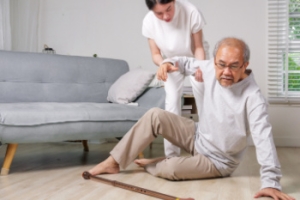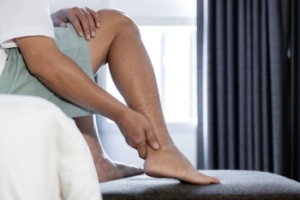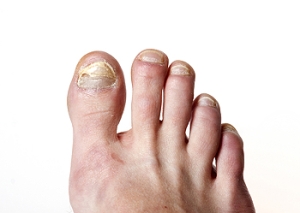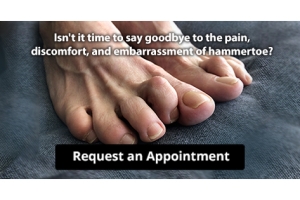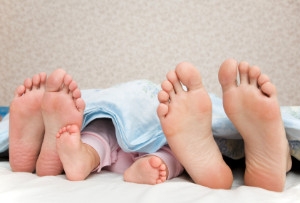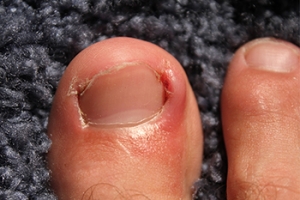
Dangers of Falls Among Seniors

As you age, the risk of falls becomes a serious concern. Statistics reveal that more than one-fourth of older adults experience a fall each year. Many falls go unreported to doctors despite the doubled chances of falling again after the first incident. Falls often result in severe consequences, such as broken bones or head injuries that may compromise physical health and reduce independence. Contributing factors to falling include foot pain or wearing poorly fitting footwear. Additionally, lower body weakness, vision problems, and medication side effects can contribute to the risk of falls in older adults. To help prevent falls, seniors are encouraged to schedule appointments with a podiatrist to assess foot health, footwear, and gait abnormalities. Engaging in regular strength and balance exercises can help by improving stability and reducing fall risk. Regular eye exams and updating eyeglasses as needed can enhance visual clarity, especially for outdoor activities. Making the home environment safer by eliminating trip hazards, installing grab bars in bathrooms, and ensuring adequate lighting is also important in fall prevention. If you have injured your feet during a fall, it is suggested that you schedule an appointment with a podiatrist.
Preventing falls among the elderly is very important. If you are older and have fallen or fear that you are prone to falling, consult with Neeta Hasmukh, DPM from Total Podiatry. Our doctor will assess your condition and provide you with quality advice and care.
Every 11 seconds, an elderly American is being treated in an emergency room for a fall related injury. Falls are the leading cause of head and hip injuries for those 65 and older. Due to decreases in strength, balance, senses, and lack of awareness, elderly persons are very susceptible to falling. Thankfully, there are a number of things older persons can do to prevent falls.
How to Prevent Falls
Some effective methods that older persons can do to prevent falls include:
- Enrolling in strength and balance exercise program to increase balance and strength
- Periodically having your sight and hearing checked
- Discuss any medications you have with a doctor to see if it increases the risk of falling
- Clearing the house of falling hazards and installing devices like grab bars and railings
- Utilizing a walker or cane
- Wearing shoes that provide good support and cushioning
- Talking to family members about falling and increasing awareness
Falling can be a traumatic and embarrassing experience for elderly persons; this can make them less willing to leave the house, and less willing to talk to someone about their fears of falling. Doing such things, however, will increase the likelihood of tripping or losing one’s balance. Knowing the causes of falling and how to prevent them is the best way to mitigate the risk of serious injury.
If you have any questions, please feel free to contact our offices located in San Antonio, Uvalde, and Jourdanton, TX . We offer the newest diagnostic and treatment technologies for all your foot care needs.
Falls Prevention
Elderly Americans are very susceptible to falls as they get older. Everyone experiences decreases in flexibility, balance, strength, and the senses as they age. This correlates to some eye-opening statistics. 1 in 4 Americans aged 65 and older fall each year. An elderly American is being treated for a fall in an emergency room every 11 seconds. In light of these striking statistics, one can see the importance of taking steps to prevent falls.
Finding an exercise program for the elderly is an excellent way to reduce the likelihood of falls. Look for an exercise program that improves strength and balance. Elderly people who live a more sedentary lifestyle, with little physical activity, are at an increased risk of falling. Wearing well-fitted footwear that provides good foot support and cushion will help prevent falls from poorly fitted shoes. Talking to a podiatrist about your susceptibility to falls and about inspecting your prescriptions will help to avoid any medication that could make falls more likely. Due to a decline in the senses among the elderly, having your eyes and hearing checked is recommended.
Around half of all falls occur in the household. Removing tripping hazards in the home and making it more accommodating to older persons can significantly reduce falls. Some notable household changes include increasing lighting around the house, installing grab bars in the shower and bathroom, and making sure the floor is clear of clutter. Other smart options include installing a shower chair, using rubber-bottomed rugs, and placing railings on both sides of stairwells.
Finally, discuss with a doctor and your family about your fear of falling. This will help to increase awareness among the population on the need for fall prevention. A lack of awareness on the matter, and a downplaying of importance are what increase the risks of falling. Following these tips can help to reduce the risk for yourself and your loved ones.
Causes and Treatment of an Achilles Tendon Injury

Achilles tendon injuries are common for both athletes and occasional exercisers, presenting significant challenges due to the tendon's pivotal role in mobility. Often triggered by overuse, athletes may push their limits too quickly or neglect proper stretching before physical activity. Also, factors like wearing high heels or foot issues like flat feet can heighten the risk of an Achilles tendon injury. Symptoms typically include pain along the back of the foot and above the heel, and can be worsened by ankle stretching or toe-standing. Diagnosis involves a thorough physical examination by a podiatrist, who also may order imaging tests like an ultrasound or MRI scans to assess the extent of damage. Treatment options vary based on severity and may include prescribing anti-inflammatory medication or certain exercises for rehabilitation. In severe cases or complete tears, surgery may be necessary for tendon repair. If you have injured your Achilles tendon, it is suggested that you schedule an appointment with a podiatrist for a full exam, diagnosis, and suggested treatment plan.
Achilles tendon injuries need immediate attention to avoid future complications. If you have any concerns, contact Neeta Hasmukh, DPM of Total Podiatry. Our doctor can provide the care you need to keep you pain-free and on your feet.
What Is the Achilles Tendon?
The Achilles tendon is a tendon that connects the lower leg muscles and calf to the heel of the foot. It is the strongest tendon in the human body and is essential for making movement possible. Because this tendon is such an integral part of the body, any injuries to it can create immense difficulties and should immediately be presented to a doctor.
What Are the Symptoms of an Achilles Tendon Injury?
There are various types of injuries that can affect the Achilles tendon. The two most common injuries are Achilles tendinitis and ruptures of the tendon.
Achilles Tendinitis Symptoms
- Inflammation
- Dull to severe pain
- Increased blood flow to the tendon
- Thickening of the tendon
Rupture Symptoms
- Extreme pain and swelling in the foot
- Total immobility
Treatment and Prevention
Achilles tendon injuries are diagnosed by a thorough physical evaluation, which can include an MRI. Treatment involves rest, physical therapy, and in some cases, surgery. However, various preventative measures can be taken to avoid these injuries, such as:
- Thorough stretching of the tendon before and after exercise
- Strengthening exercises like calf raises, squats, leg curls, leg extensions, leg raises, lunges, and leg presses
If you have any questions please feel free to contact our offices located in San Antonio, Uvalde, and Jourdanton, TX . We offer the newest diagnostic tools and technology to treat your foot and ankle needs.
Achilles Tendon Injuries
The Achilles tendon is the largest tendon in the body; it is a tough band of fibrous tissue that stretches from the bones of the heel to the calf muscles. This tendon is what allows us to stand on our toes while running, walking, or jumping, it is common for this tendon to become injured. In severe cases, the Achilles tendon may become partially torn or completely ruptured. However, this tendon is susceptible to injury because of its limited blood supply and the high level of tension it endures.
The people who are more likely to suffer from Achilles tendon injuries are athletes who partake in activities that require them to speed up, slow down, or pivot. Consequently, athletes who engage in running, gymnastics, dance, football, baseball, basketball, or tennis are more likely to suffer from Achilles tendon injuries. Additionally, there are other factors that may make you more prone to this injury. People who wear high heels, have flat feet, tight leg muscles or tendons, or take medicines called glucocorticoids are more likely to have Achilles tendon injuries.
A common symptom of an Achilles tendon injury is pain above the heel that is felt when you stand on your toes. However, if the tendon is ruptured, the pain will be severe, and the area may become swollen and stiff. Other symptoms may be reduced strength in the lower ankle or leg area, and reduced range of motion in the ankle. When the Achilles tendon tears, there is usually a popping sound that occurs along with it. People who have acute tears or ruptures may find walking and standing to be difficult.
If you suspect you have injured your Achilles tendon, you should see your podiatrist to have a physical examination. Your podiatrist will likely conduct a series of tests to diagnose your injury including a “calf-squeeze” test. Calf squeeze tests are performed by first squeezing the calf muscle on the healthy leg. This will pull on the tendon and consequently cause the foot to move. Afterward, the same test will be performed on the injured leg. If the tendon is torn, the foot won’t move because the calf muscle won’t be connected to the foot.
Managing Fungal Toenail Infections

Fungal toenail infections can be recognized by the slow development of discolored, thickened, and distorted nails, often accompanied by discomfort. Although not typically serious, fungal toenail infections can be bothersome and challenging to address. Fungal toenail infections typically arise from fungi prevalent in warm, moist environments, like gym locker rooms. Contributing factors include poor foot hygiene, sweaty footwear, and exposure to communal areas where people are likely to be barefoot. Treatment options encompass antifungal medications, although it may take a long time and cause side effects. While mild cases may resolve without intervention, severe infections often necessitate medical attention. It is suggested that you schedule an appointment with a podiatrist for an accurate diagnosis and options for more advanced treatment.
If left untreated, toenail fungus may spread to other toenails, skin, or even fingernails. If you suspect you have toenail fungus it is important to seek treatment right away. For more information about treatment, contact Neeta Hasmukh, DPM of Total Podiatry. Our doctor can provide the care you need to keep you pain-free and on your feet.
Symptoms
- Warped or oddly shaped nails
- Yellowish nails
- Loose/separated nail
- Buildup of bits and pieces of nail fragments under the nail
- Brittle, broken, thickened nail
Treatment
If self-care strategies and over-the-counter medications does not help your fungus, your podiatrist may give you a prescription drug instead. Even if you find relief from your toenail fungus symptoms, you may experience a repeat infection in the future.
Prevention
In order to prevent getting toenail fungus in the future, you should always make sure to wash your feet with soap and water. After washing, it is important to dry your feet thoroughly especially in between the toes. When trimming your toenails, be sure to trim straight across instead of in a rounded shape. It is crucial not to cover up discolored nails with nail polish because that will prevent your nail from being able to “breathe”.
In some cases, surgical procedure may be needed to remove the toenail fungus. Consult with your podiatrist about the best treatment options for your case of toenail fungus.
If you have any questions, please feel free to contact our offices located in San Antonio, Uvalde, and Jourdanton, TX . We offer the newest diagnostic and treatment technologies for all your foot care needs.
Toenail Fungus
Toenail fungus is a frustrating problem that affects many people. It can be persistent and hard to get rid of. As many different types of fungi are present throughout the environment, it is very easy to contract toenail fungus.
The feet are especially susceptible to toenail fungus because shoes and socks create the ideal dark and moist environment that fungal infections thrive in. While fungal infections of the nail plate are quite common, if left untreated they can spread beyond the toenail and into the skin and other parts of the body.
Signs of toenail fungus include a thickened nail that has become yellow or brown in color, a foul smell, and debris beneath the nail. The toe may become painful due to the pressure of a thicker nail or the buildup of debris.
Treatment for toenail fungus is most effective during the early stages of an infection. If there is an accumulation of debris beneath the nail plate, an ingrown nail or a more serious infection can occur. While each treatment varies between patients, your podiatrist may prescribe you oral medications, topical liquids and creams, or laser therapy. To determine the best treatment process for you, be sure to visit your podiatrist at the first signs of toenail fungus.
Children’s Foot and Heel Pain Causes
 Children's foot and heel pain, or CFHP, encompasses a variety of conditions that can impact children’s ability to engage in activities and sports without discomfort. One common cause of CFHP is Sever's disease, a condition that results from inflammation of the growth plate in the heel. Sever’s disease is often seen in active children undergoing growth spurts. Additionally, flat feet or overpronation can strain the foot's muscles and ligaments, causing pain. Improper footwear, intense physical activity, and obesity may also contribute to the development of CFHP. Symptoms typically include pain in the foot or heel, particularly during or after physical activities, and might be accompanied by swelling or redness. Addressing CFHP involves a combination of rest, wearing appropriate footwear, and sometimes orthotic devices to support the foot's structure. Early diagnosis and treatment are important to prevent chronic problems and ensure that children can participate in their favorite activities without pain. If your child is suffering with foot or heel pain, it is suggested that you schedule an appointment with a podiatrist today.
Children's foot and heel pain, or CFHP, encompasses a variety of conditions that can impact children’s ability to engage in activities and sports without discomfort. One common cause of CFHP is Sever's disease, a condition that results from inflammation of the growth plate in the heel. Sever’s disease is often seen in active children undergoing growth spurts. Additionally, flat feet or overpronation can strain the foot's muscles and ligaments, causing pain. Improper footwear, intense physical activity, and obesity may also contribute to the development of CFHP. Symptoms typically include pain in the foot or heel, particularly during or after physical activities, and might be accompanied by swelling or redness. Addressing CFHP involves a combination of rest, wearing appropriate footwear, and sometimes orthotic devices to support the foot's structure. Early diagnosis and treatment are important to prevent chronic problems and ensure that children can participate in their favorite activities without pain. If your child is suffering with foot or heel pain, it is suggested that you schedule an appointment with a podiatrist today.
The health of a child’s feet is vital to their overall well-being. If you have any questions regarding foot health, contact Neeta Hasmukh, DPM of Total Podiatry. Our doctor can provide the care you need to keep you pain-free and on your feet.
Tips for Keeping Children's Feet Healthy
- Make sure their shoes fit properly
- Look for any signs of in-toeing or out-toeing
- Check to see if they have Clubfoot (condition that affects your child’s foot and ankle, twisting the heel and toes inward) which is one of the most common nonmajor birth defects.
- Lightly cover your baby’s feet (Tight covers may keep your baby from moving their feet freely, and could prevent normal development)
- Allow your toddler to go shoeless (Shoes can be restricting for a young child’s foot)
- Cut toenails straight across to avoid ingrown toenails
- Keep your child’s foot clean and dry
- Cover cuts and scrapes. Wash any scratches with soap and water and cover them with a bandage until they’ve healed.
If you have any questions, please feel free to contact our offices located in San Antonio, Uvalde, and Jourdanton, TX . We offer the newest diagnostic and treatment technologies for all your foot care needs.
How to Care for Your Child's Feet
It is never normal for a child to experience pain in his or her feet. Foot pain that lasts more than a few days and limits a child’s ability to walk should be examined by a podiatrist. Many adult foot ailments originate in childhood and may be present at birth. Common foot issues that are experienced by children are pediatric flat foot, Sever’s disease, ingrown toenails, and plantar warts.
A child’s foot grows rapidly during the first year, allowing it to reach almost half of their adult foot size. Consequently, foot specialists consider the first year to be the most crucial point in the foot development process. There are ways you can help ensure that your child’s foot develops properly. One way is to carefully look at your baby’s feet. If you notice any deformities, you should immediately seek professional care. You should also loosely cover your child’s foot, since tight coverings may prevent movement and inhibit normal development. Another tip is to change the baby’s positioning throughout the day. If your baby lies down in one spot for too long, it may put an excess amount of strain on the feet and legs.
It is best that you try not to force a child to start walking. Children will begin to walk when they are both physically and emotionally capable to do so. You should also avoid comparing your child’s walking progress with other children because the age range for independent walking may range. When your child’s feet begin to develop, you may need to change both their shoe and sock size every few months to allow room for their feet to grow.
Kids are sometimes prone to splinters, cuts, and severe injuries because they tend to walk around barefoot. This also makes them more susceptible to developing plantar warts which is a condition caused by a virus that invades the sole of the foot through breaks in the skin. These ailments can be avoided by making sure your child wears shoes in unsanitary environments. You should also wash any minor cuts or scrapes on your child’s feet. It is a myth that exposure to fresh air will heal injuries; fresh air will only expose your child’s cuts to germs.
As a parent, you should ensure that your child’s feet are developing properly and are being properly maintained. Consequently, it is important that you perform routine inspections on his or her feet to detect any injuries or deformities in their early stages. Early detection and treatment will help to ensure that your child does not develop any serious foot conditions.
Signs of an Ingrown Toenail
 An ingrown toenail, a common yet uncomfortable condition, occurs when the edge of a toenail grows into the surrounding skin. This often happens on the big toenail. Typical signs include redness and swelling around the affected area, and pain and tenderness when pressure is applied to the toe. More severe cases may involve an infection, which is often indicated by pus or fluid buildup. Some people might also notice the skin next to the nail becoming harder or the nail itself appearing overly curved or thickened. These symptoms not only cause discomfort but can also restrict footwear choices and make walking or standing painful. Recognizing these signs early is important for seeking appropriate treatment to prevent the condition from worsening and to alleviate the discomfort it causes. If you are suffering from an ingrown toenail, it is suggested you make an appointment with a podiatrist, a foot doctor who can effectively treat this condition.
An ingrown toenail, a common yet uncomfortable condition, occurs when the edge of a toenail grows into the surrounding skin. This often happens on the big toenail. Typical signs include redness and swelling around the affected area, and pain and tenderness when pressure is applied to the toe. More severe cases may involve an infection, which is often indicated by pus or fluid buildup. Some people might also notice the skin next to the nail becoming harder or the nail itself appearing overly curved or thickened. These symptoms not only cause discomfort but can also restrict footwear choices and make walking or standing painful. Recognizing these signs early is important for seeking appropriate treatment to prevent the condition from worsening and to alleviate the discomfort it causes. If you are suffering from an ingrown toenail, it is suggested you make an appointment with a podiatrist, a foot doctor who can effectively treat this condition.
Ingrown toenails may initially present themselves as a minor discomfort, but they may progress into an infection in the skin without proper treatment. For more information about ingrown toenails, contact Neeta Hasmukh, DPM of Total Podiatry. Our doctor can provide the care you need to keep you pain-free and on your feet.
Ingrown Toenails
Ingrown toenails are caused when the corner or side of a toenail grows into the soft flesh surrounding it. They often result in redness, swelling, pain, and in some cases, infection. This condition typically affects the big toe and may recur if it is not treated properly.
Causes
- Improper toenail trimming
- Genetics
- Improper shoe fitting
- Injury from pedicures or nail picking
- Abnormal gait
- Poor hygiene
You are more likely to develop an ingrown toenail if you are obese, have diabetes, arthritis, or have any fungal infection in your nails. Additionally, people who have foot or toe deformities are at a higher risk of developing an ingrown toenail.
Symptoms
Some symptoms of ingrown toenails are redness, swelling, and pain. In rare cases, there may be a yellowish drainage coming from the nail.
Treatment
Ignoring an ingrown toenail can have serious complications. Infections of the nail border can progress to a deeper soft-tissue infection, which can then turn into a bone infection. You should always speak with your podiatrist if you suspect you have an ingrown toenail, especially if you have diabetes or poor circulation.
If you have any questions, please feel free to contact our offices located in San Antonio, Uvalde, and Jourdanton, TX . We offer the newest diagnostic and treatment technologies for all your foot care needs.
